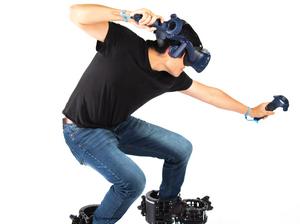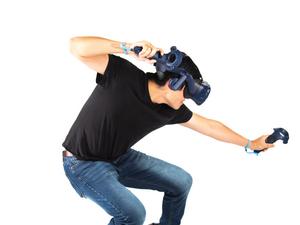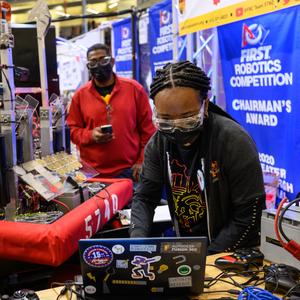Let's face it, after a year of at-home meetings, people are having trouble just looking at Zoom all day.
Now, some local companies are aiming to spice things up a bit by developing new ways to train workers and conduct that virtual happy hour.
“The thing I find very exciting is people were exploring more,” said David Lindlbauer, assistant professor in Carnegie Mellon University’s Human-Computer Interaction Institute. “Everyone was looking for solutions to break Zoom fatigue or to break into this space and provide richer experiences that are more beneficial for users.”
While the Covid-19 pandemic forced companies across the region to accelerate the adoption of technologies and shift many workplace processes onto remote platforms, there has been tremendous interest in developing and adopting new technologies to help with things like workforce training, professional development, networking and events.
Some of the latest technologies use virtual reality, which uses a headset to completely take over a user's visual field, providing an entirely immersive experience, or augmented reality, which allows users to see virtual elements layered on top of normal sight.
A report published by PwC, called “Seeing is believing,” projects that virtual and augmented reality have the potential to boost the global economy by $1.5 trillion by 2030 from a current GDP contribution of $46.4 billion. More specifically, $294.2 billion of that spike is expected to come directly from development and training applications.
Simulation training — real-life feel from your homes
Using virtual and augmented reality for simulation training in high-stakes situations like performing an operation or flying an airplane has become increasingly common.
Lindlbauer noted he has heard of VR training applications used by flight agencies to train pilots.
“It is these high risk, or at least high stakes, industries where there is a big push toward VR,” he said.
One local company that has broken into this space is Pittsburgh-based Ekto VR, which creates robotic boots that match a users’ motions in a virtual reality headset while allowing the user to stay in a small space.
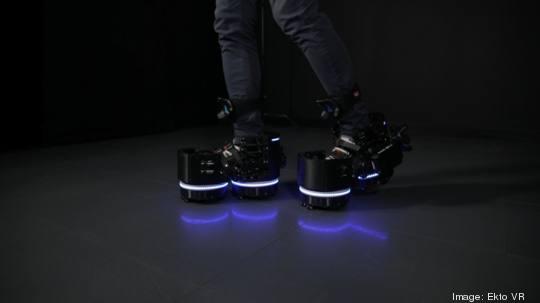
In June, Ekto VR raised $340,000 from Reinforced Ventures, bringing its total fundraised amount to $600,000. The startup plans to use the money for product development and hiring, as well as to launch its partner beta program by the end of 2021.
Brad Factor, founder and CEO of Ekto VR, said interest in virtual and augmented reality training grew tremendously over the course of the pandemic.
“We saw an initial reaction of, ‘We don’t know how long this is going to take, so let’s put as much training on hold as we can,’” Factor said. “But obviously there are limitations as far as regulator situations. Especially in those circumstances, we saw a trend toward doing remote, but a lot of the training can’t be done in videos and PowerPoints. You can’t hop on a Zoom call and get familiarized with an offshore oil rig.”
Factor said VR adoption picked up most quickly in these kind of industrial cases where training is closely regulated. Companies could build out modules and then send VR headsets to employees to do the training in their homes.
For example, to train employees in the oil and gas industry, they must understand the physical layout of the facility and how the machinery works.
“This training is built out so they can see each of those areas,” Factor said. “They feel like they are on this oil rig, and they can look at their given station and see what it is going to look like in real life. All of it feels like you are actually there on the rig.”
Pittsburgh-based startup Lumis Corp. uses augmented reality to help another industry that also needs to quickly develop and adopt new training techniques – health care.
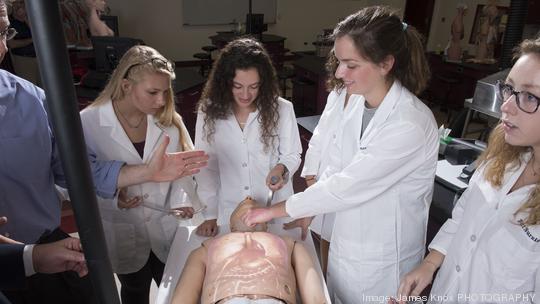
Lumis, which has four full-time employees, uses a mannequin and an augmented reality projection system to do in-person training for medical students. The AR projects images of anatomy and physiology onto the mannequin, and then students can practice surgeries and other medical procedures, according to Doug Nelson, CEO of Lumis.
Nelson did not disclose specifically how much funding Lumis has raised, but said it fell between $500,000 and $1 million. Nelson also did not disclose the names of the clients it works with, but he said customers include academic medical centers, universities and community colleges in Pennsylvania, Virginia, Michigan and Illinois.
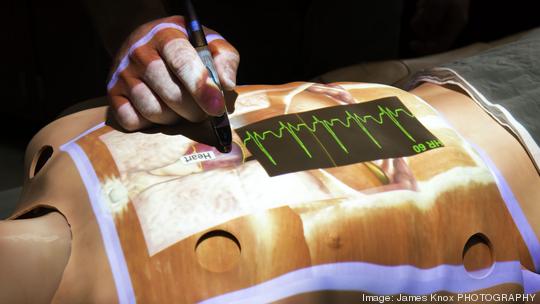
During the pandemic, Lumis did pivot much of its tech to an online platform for remote learning, but the company, which declined to disclose revenue, kept as many engaging elements of its augmented reality system as possible.
“For many small businesses the pandemic has hit really hard, and I think, for us, we have certainly felt that burden,” Nelson said. “But not quite as much as those traditional businesses. The pandemic has equalized companies in the health care training space, and in some ways, the pandemic has helped us push out value proposition for scalable trainings.”
Leadership training - virtual interactions
However, adoption of VR, AR and other technologies is not just for high-risk processes. It’s also increasing in areas such as networking or professional development.
Development Dimensions International Inc., a human resources consulting group in Allegheny County, is working with Strivr, a virtual reality training company, on developing virtual reality leadership development training with an initial focus on diversity, equity and inclusion.
Sage Krombolz, product manager at DDI, said the company first launched VR products for this type of training in 2019.
The first iteration was a VR simulation that allows leaders to experience being excluded, undervalued and marginalized at work. For example, while using the headset, the leaders would experience things like being interrupted, unfair assumptions about their qualifications and not being believed by their manager.
“The simulation is eight minutes long, but what we have seen is that it provides a level of realism that enables people to experience some of the emotional responses that would come up,” Krombolz said. “People’s palms sweat, their hearts race.”
Now, DDI and Strivr are working to further develop this kind of soft skills VR training. They have plans for three more simulations — one on delivering feedback for improvement to a direct report, one on presenting a process change to a team that is met with resistance and another on resolving conflict between two direct reports.
“We are building out a catalog of several simulations that just like the first experience would be couched within a two-hour facilitated session where leaders have a chance to put on the headset and have conversation with someone at work and try some of the leadership skills and best practices that are going to help that run smoothly,” Krombolz said.
Dave Rea, managing director of the human capital team at Catalyst Connection, which works with small and midsized manufacturers, saw some of this training in action.
“I saw (it) in one of the meetings, and the technology would enable people to simulate interactions and conversations, and it will be able to respond based on what you say as a learner,” Rea said. “If you say something that is offensive to someone, the simulated person that you are interacting with, maybe their body language would change, and you have to respond back based on their body language.”
Rea expects tech in leadership training will be more widely adopted by manufacturers over the next three to five years.
Krombolz declined to disclose the names of specific companies that it works with, but said over the past two years the company worked with about 20 to 30 clients on these kind of trainings.
“One of the trends that is more recent as people are getting vaccinated and people are going back to offices and budgets starting to return is that organizations are starting to move from dipping their toes in the water with VR and renting a set of headsets for a couple days to really being able to justify an ongoing use case for VR,” Krombolz said. “We’re seeing organizations purchasing their own fleets of headsets.”
Companies also are increasingly using VR not only for training, but also for collaboration.
Karen Alexander, director of Pittsburgh-based XRconnectED, said that over the course of the pandemic, the number of opportunities to do remote work in virtual reality has grown rapidly.
Alexander said XRcollaboration.com launched in March 2020 to provide employers with platforms for VR collaboration. She said that at that time the website had about 70 platforms, and it now has more than 250.
These platforms vary dramatically, but, for example, could include a 3D version of an office where employees can interact as avatars.
“The growth of these collaborative platforms and the sort of collaborations that can take place depending on the platform could be engineers doing design review or architects bringing their clients to look at a product,” Alexander said.
Working to overcome the challenges
Yet, many challenges remain in the adoption of these kind of technologies. First and foremost, Lindlbauer questioned how employees that have trouble looking at Zoom for hours at a time could be expected to wear VR headsets for multiple hours.
Furthermore, Lindlbauer said these technologies still need a great deal of work.
“One main challenge is what we see for a lot of training scenarios is that they are kind of game-like or scripted scenarios,” Lindlbauer said. “What I feel like is missing is the close interaction you would have between instructor and trainee.”
Lindlbauer said technologists are still working on how to represent or depict people in virtual reality settings. In some cases, an avatar might work fine, but in others it may be necessary to actually see the person’s face.
“We still don’t know how lifelike or how real the representation needs to be to really bridge this gap,” Lindlbauer said.
Facebook Reality Labs is working on exactly this question with the development of its extremely lifelike Codec Avatars.
“Facebook Reality Labs’ Pittsburgh office is developing technology that will let people put on a VR headset, no matter where they are, and be instantly transported into a meeting or training and feel like they’re really there in person with their team,” Yaser Sheikh, director of Facebook Reality Labs in Pittsburgh, said. “Lifelike avatars — what we call Codec Avatars — allow people to share a space with others and create a deeper and far more satisfying sense of connection in VR than seeing someone on a flat screen.”
However, Lindlbauer said while there has been a push by major companies to release VR headsets — like Facebook’s Oculus — they are far from an ubiquitous device, like smartphones. Until that happens, he said these expensive devices will not achieve widespread use in workplaces.
Brooke Morrill, senior director of education at Schell Games, agreed. While AR and VR are both coming of age and more options are becoming available, the headsets remain expensive. For example, the popular Oculus VR headsets made by Facebook start at $299.
“I think people are interested, but there are still practical issues that impede its large-scale adoption at this point,” Morrill said.
She promoted the use of AR and VR tech in training employees because it improves data collection on participant performance and can help trainers understand exactly where an employee might be struggling the most.
Alexander shared that thought.
“The number of data points that can be collected from a person when they are in VR or even just watching a 360 video in terms of the way their body moves and where their eyes are focused and their pulse rate, for employers, this provides them such a wealth of information about people that they are training,” Alexander said.
